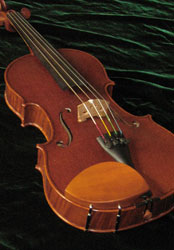

| The
Guide to Good Sound for Stringed Instruments
String Instrument Care - Preventing Damage
Heat and Humidity. Instruments should be stored in a room with 40-50% humidity to avoid cracking the top. Use a Dampit or similar product during the winter. Never leave an instrument near a radiator, heat vent or in a car. Strings. Reduce wear by using a No. 1 pencil to lubricate notches in the bridge, nut, and pegs when you replace a string. Clean strings after playing, using a dry and clean cloth. Fine tuners. Avoid cracking or chipping the varnish by checking the underside of finetuners to ensure they are not touching the top of the instrument. Bow. Clean rosin from the underside of the bow, using a dry and clean cloth. Release tension on the bow before putting it away in its case. The Fall season is extremely hard on bows once you turn on your heat. After taking the bow out into the cold, remember to allow it time to warm up to room temperature before playing or the head may snap off. Case. Put your instrument in its case after use. Always close the top of the case. Make sure the latch is properly closed and zip the case shut. When traveling, put the case directly into the car. Never put the case down on the sidewalk or street. Getting Better Sound: Avoiding Technique Busters
Warped Bows. Check for warps. Compensating for a warped bow as you play can cause tension, which can lead to poor tone production. Dirty Bow Hairs. Keep bow hair clean. Oil from your hands can prevent the hair from properly gripping the strings. This causes the bow to "skate," which produces a thin note. Incorrect Neck Measurements. Necks that are too thick or too wide make notes hard to reach. Have a violinmaker check for correct measurements. Incorrect String Lengths. The length along the string between the nut and the bridge must be correct to ensure notes aren't too close or too far apart on the fingerboard. Improper string length can result in poor intonation and tension in your hand. Have a violinmaker check for correct string lengths. Getting Better Sound: Avoiding Tone Killers
Frayed or Discolored Strings. Worn strings reduce richness of tone and the instrument's ability to project sound. Incorrect String Heights Over the Fingerboard. Strings that are too high can produce a strident tone. Low strings can produce a weak tone. Either can make the instrument difficult to play. Have a violinmaker check for correct string heights. Incorrect Neck Angle. A neck that is too steeply angled upward puts too much tension on the top of the instrument, producing a "tight" sound. Too low an angle can rob the instrument of projection. Open Seams. The "seam" is where the top and back of the instrument meet the sides ("ribs"). Open seams are a leading cause of a strident tone on treble strings and weak tone on bass strings. Seams typically open in very dry or humid weather. Incorrect Bridge Thickness. Bridges that are too thick muffle the tone. A thin bridge can cause your instrument to produce a loud, strident sound. Have a violinmaker check for correct bridge thickness. |


